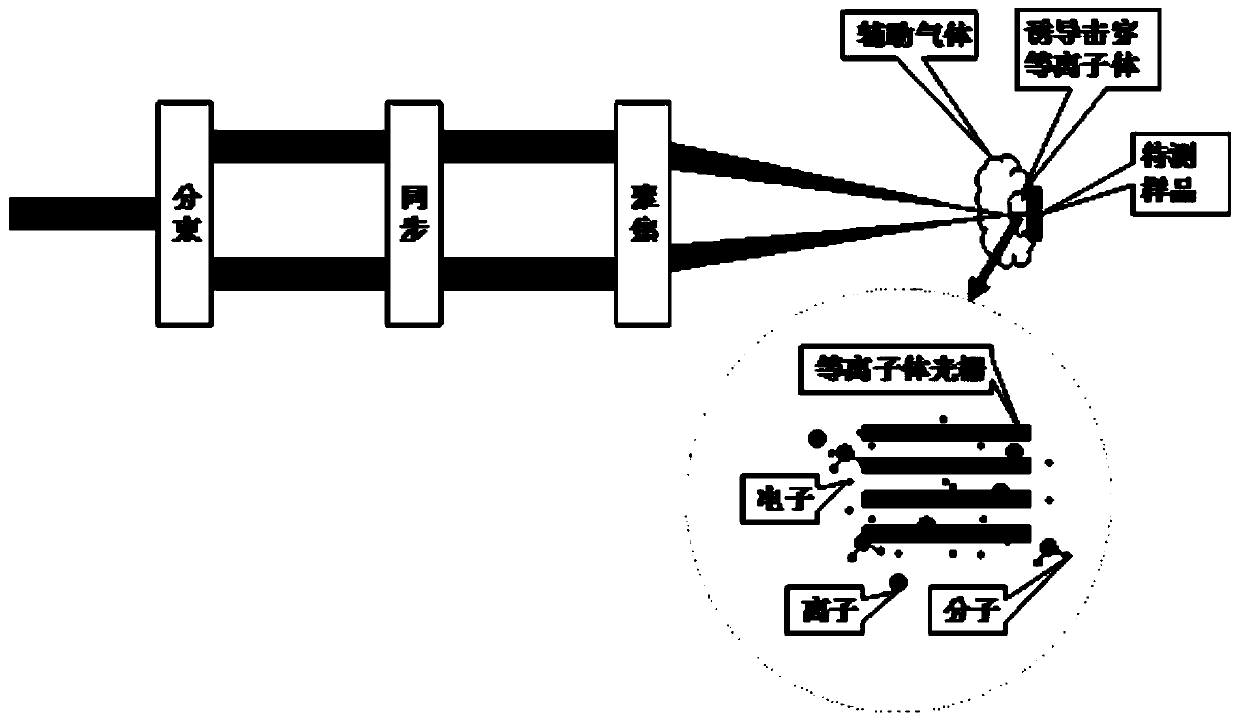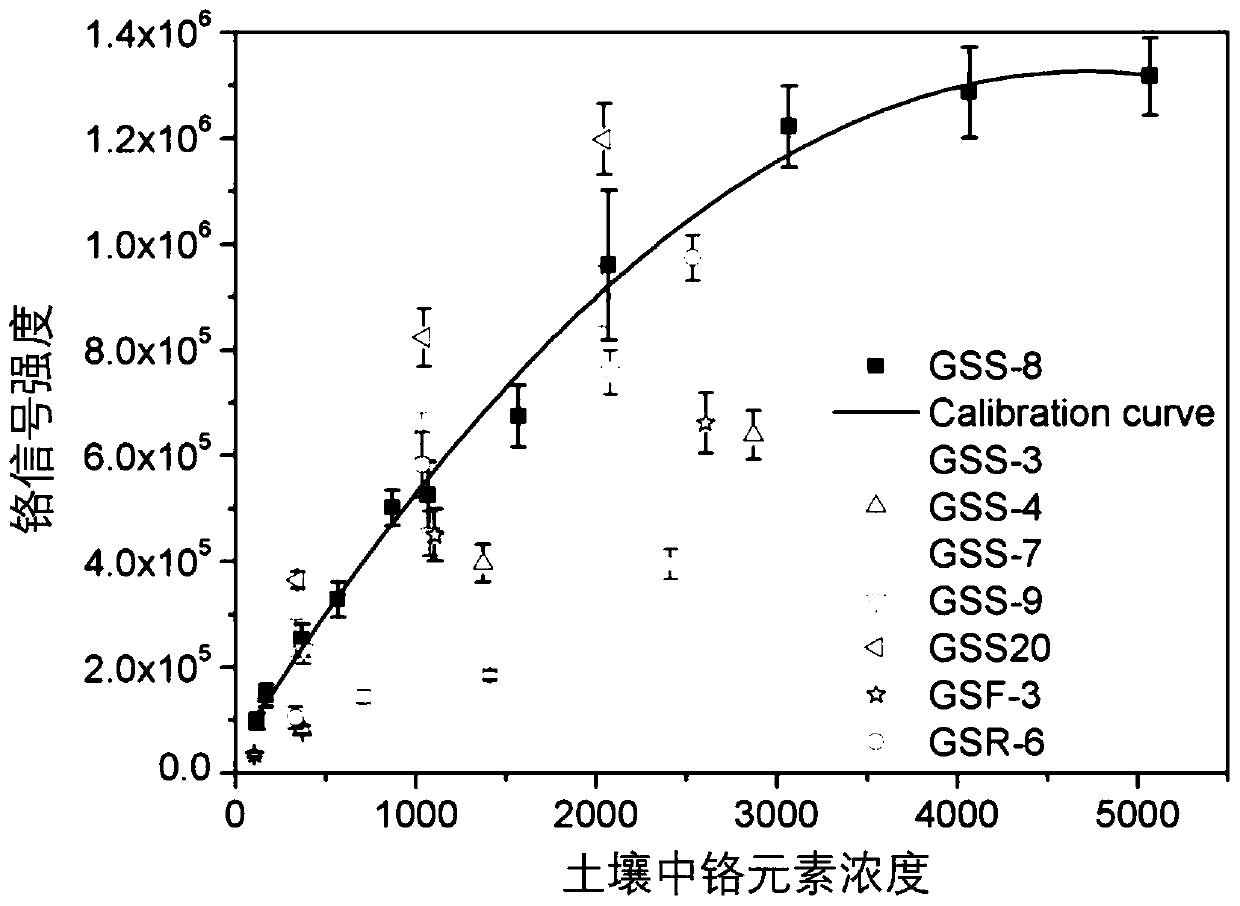Non-standard-sample calibration method adopting femtosecond plasma channel breakdown spectroscopy
A technology of plasma and breakdown spectroscopy, applied in the field of element detection, can solve the problems of matrix effect, low detection sensitivity, difficult calibration, etc., and achieve the effect of small pulse width, overcoming mutual interference, and enhancing spectral signal.
- Summary
- Abstract
- Description
- Claims
- Application Information
AI Technical Summary
Problems solved by technology
Method used
Image
Examples
Embodiment 1
[0060] figure 1 It is the schematic diagram of the breakdown spectrum induced by femtosecond optical fiber or femtosecond plasma grating. The principle of the method is as follows figure 1 As shown, a beam of femtosecond pulsed laser is directly focused to form a filament-like plasma channel, or two beams of filaments formed after beam splitting, time-domain synchronization, and focusing interact with each other to form a plasma grating with spatial period modulation The structure acts on the sample to be tested, excites the sample to be tested, and obtains the plasma breakdown fluorescence transition spectrum, thereby realizing the detection of the elements in the sample.
[0061] figure 2 Schematic diagram of the breakdown spectrum structure of the femtosecond plasma grating. The structure of the detection device includes a laser 1, a beam splitting module 2, a time domain synchronization module 3, a focusing module 4, an object carrying module 5, and a spectrum collection mod...
Embodiment 2
[0063] Weigh 0.2 g of several soils with different chromium element concentrations and press them with a hydraulic press at a pressure of 4 MPa for 1 minute to obtain soil compacts with a diameter of 13 mm for testing. A single-pulse energy of 60mJ and a nanosecond laser pulse with a repetition frequency of 5Hz was focused on the surface of the soil sample tablet to test the spectral signal intensity of chromium in the soil.
[0064] image 3 The relationship between the signal intensity of 427.4nm spectral line of chromium and the concentration of chromium in different soils tested. It can be seen that the traditional method of direct compression and nanosecond laser testing of the element signal intensity and concentration relationship of different soils is basically inconsistent, indicating that there is an obvious matrix effect in the test at this time, which will make it impossible to determine the soil elements. Cannot be quantitatively tested.
Embodiment 3
[0066] Weigh 0.2 g of several soils with different chromium element concentrations and press them with a hydraulic press at a pressure of 4 MPa for 1 minute to obtain soil compacts with a diameter of 13 mm for testing. The femtosecond laser pulse with a single pulse energy of 0.3 mJ and a repetition frequency of 1 kHz was focused on the surface of the soil sample tablet to test the spectral signal intensity of chromium in the soil.
[0067] Figure 4 The relationship between the signal intensity of 427.4nm spectral line of chromium and the concentration of chromium in different soils tested. It can be seen that although the relationship between the signal intensity and concentration of the element signal in different soils is not consistent enough with the femtosecond laser to directly press the tablet, it has shown a certain linear correlation, indicating that the femtosecond laser at this time has already begun to weaken the suppression matrix effect. Effective.
PUM
| Property | Measurement | Unit |
|---|---|---|
| diameter | aaaaa | aaaaa |
Abstract
Description
Claims
Application Information
 Login to View More
Login to View More - R&D
- Intellectual Property
- Life Sciences
- Materials
- Tech Scout
- Unparalleled Data Quality
- Higher Quality Content
- 60% Fewer Hallucinations
Browse by: Latest US Patents, China's latest patents, Technical Efficacy Thesaurus, Application Domain, Technology Topic, Popular Technical Reports.
© 2025 PatSnap. All rights reserved.Legal|Privacy policy|Modern Slavery Act Transparency Statement|Sitemap|About US| Contact US: help@patsnap.com



